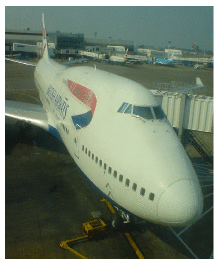
5 Planes
Imagine that you make one intercontinental trip per year by plane. How much energy does that cost?
A Boeing 747-400 1 with 240 000 litres of fuel carries 416 passengers about 8 800 miles (14 200 km). And fuel’s calorific value is 10 kWh per litre. (We learned that in Chapter 3.) So the energy cost of one full-distance roundtrip on such a plane, if divided equally among the passengers, is
[\begin{matrix} {\frac{\text{2\ ×\ 240\ 000\ litre}}{\text{416\ passengers}} \times \text{10\ kWh/litre}} \ {\simeq \text{12\ 000\ kWh\ per\ passenger}} \ \end{matrix}]
If you make one such trip per year, then your average energy consumption per day is
[\frac{\text{12\ 000\ kWh}}{\text{365\ days}} \simeq \text{33\ kWh/day}]
14 200 km is a little further than London to Cape Town (10 000 km) and London to Los Angeles (9000km), so I think we’ve slightly overestimated the distance of a typical long-range intercontinental trip; but we’ve also overestimated the fullness of the plane, and the energy cost per person is more if the plane’s not full. Scaling down by 10 000 km/14 200 km to get an estimate for Cape Town, then up again by 100/80 to allow for the plane’s being 80% full, we arrive at 29 kWh per day. For ease of memorization, I’ll round this up to 30 kWh per day.
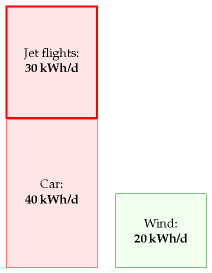
Let’s make clear what this means. Flying once per year has an energy cost slightly bigger than leaving a 1 kW electric fire on, non-stop, 24 hours a day, all year.
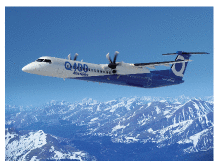
Just as Chapter 3, in which we estimated consumption by cars, was accompanied by Chapter A, offering a model of where the energy goes in cars, this chapter’s technical partner (Chapter C), discusses where the energy goes in planes. Chapter C allows us to answer questions such as “would air travel consume significantly less energy if we travelled in slower planes?” The answer is no: in contrast to wheeled vehicles, which can get more efficient the slower they go, planes are already almost as energy-efficient as they could possibly be. Planes unavoidably have to use energy for two reasons: they have to throw air down in order to stay up, and they need energy to overcome air resistance. No redesign of a plane is going to radically improve its efficiency. 2 A 10% improvement? Yes, possible. A doubling of efficiency? I’d eat my complimentary socks.
Queries
Energy per distance (kWh per 100 p-km)
Car (4 occupants)
20
Ryanair’s planes, year 2007
37
Bombardier Q400, full
38
747, full
42
747, 80% full
53
Ryanair’s planes, year 2000
73
Car (1 occupant)
80
Table 5.3. Passenger transport efficiencies, expressed as energy required per 100 passenger-km.Aren’t turboprop aircraft far more energy-efficient?
No. The “comfortably greener” Bombardier Q400 NextGen, “the most technologically advanced turboprop in the world,” according to its manufacturers [www.q400.com], uses 3.81 litres per 100 passenger-km (at a cruise speed of 667 km/h), which is an energy cost of 38 kWh per 100 p-km. The full 747 has an energy cost of 42 kWh per 100 p-km. So both planes are twice as fuel-efficient as a single-occupancy car. (The car I’m assuming here is the average European car that we discussed in Chapter 3.)
Is flying extra-bad for climate change in some way?
Yes, that’s the experts’ view, though uncertainty remains about this topic [3fbufz]. Flying creates other greenhouse gases in addition to CO2, such as water and ozone, and indirect greenhouse gases, such as nitrous oxides. If you want to estimate your carbon footprint in tons of CO2equivalent, then you should take the actual CO2 emissions of your flights and bump them up two- or three-fold. This book’s diagrams don’t include that multiplier because here we are focusing on our energy balance sheet.
The best thing we can do with environmentalists is shoot them.
Michael O’Leary, CEO of Ryanair [3asmgy]
Notes and further reading
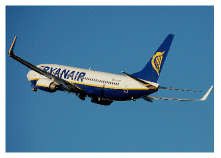
What about short-haul flights? In 2007, Ryanair, “Europe’s greenest airline,” delivered transportation at a cost of 37 kWh per 100 p-km [3exmgv]. This means that flying across Europe with Ryanair has much the same energy cost as having all the passengers drive to their destination in cars, two to a car. (For an indication of what other airlines might be delivering, Ryanair’s fuel burn rate in 2000, before their environment-friendly investments, was above 73 kWh per 100 p-km.) London to Rome is 1430 km; London to Malaga is 1735 km. So a round-trip to Rome with the greenest airline has an energy cost of 1050 kWh, and a round-trip to Malaga costs 1270 kWh. If you pop over to Rome and to Malaga once per year, your average power consumption is 6.3 kWh/d with the greenest airline, and perhaps 12 kWh/d with a less green one.
What about frequent flyers? To get a silver frequent flyer card from an intercontinental airline, it seems one must fly around 25 000 miles per year in economy class. That’s about 60 kWh per day, if we scale up the opening numbers from this chapter and assume planes are 80% full.
Here are some additional figures from the Intergovernmental Panel on Climate Change [yrnmum]: a full 747-400 travelling 10 000 km with low-density seating (262 seats) has an energy consumption of 50 kWh per 100 p-km. In a high-density seating configuration (568 seats) and travelling 4000 km, the same plane has an energy consumption of 22 kWh per 100 p-km. A shorthaul Tupolev-154 travelling 2235 km with 70% of its 164 seats occupied consumes 80 kWh per 100 p-km.
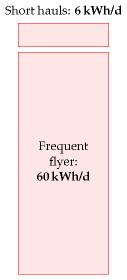
- Boeing 747-400 – data are from [9ehws]. Planes today are not completely full. Airlines are proud if their average fullness is 80%. Easyjet planes are 85% full on average. (Source: thelondonpaper Tuesday 16th January, 2007.) An 80%-full 747 uses about 53 kWh per 100 passenger-km.↩
- No redesign of a plane is going to radically improve its efficiency. Actually, the Advisory Council for Aerospace Research in Europe (ACARE) target is for an overall 50% reduction in fuel burned per passenger-km by 2020 (relative to a 2000 baseline), with 15–20% improvement expected in engine efficiency. As of 2006, Rolls Royce is half way to this engine target [36w5gz]. Dennis Bushnell, chief scientist at NASA’s Langley Research Center, seems to agree with my overall assessment of prospects for efficiency improvements in aviation. The aviation industry is mature. “There is not much left to gain except by the glacial accretion of a per cent here and there over long time periods.” (New Scientist, 24 February 2007, page 33.) The radically reshaped “Silent Aircraft” [silentaircraft.org/sax40], if it were built, is predicted to be 16% more efficient than a conventional-shaped plane (Nickol, 2008). If the ACARE target is reached, it’s presumably going to be thanks mostly to having fuller planes and better air-traffic management.↩